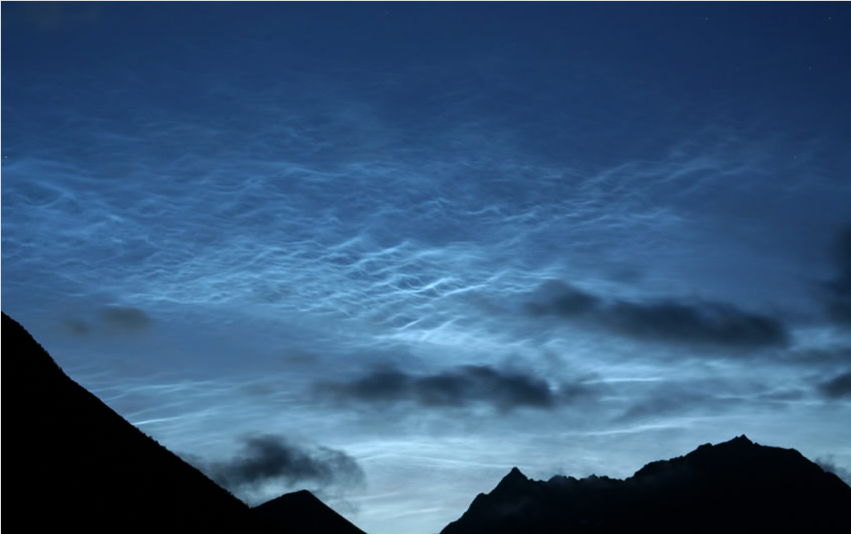Noctilucent Clouds, Norway
Noctilucent Clouds: A Mesmerizing Atmospheric Phenomenon in Norway
Noctilucent clouds, also known as polar mesospheric clouds, are a captivating atmospheric phenomenon that can be observed in the polar regions, including Norway. These ethereal clouds, which form at high altitudes in the mesosphere, create a stunning display of luminous structures against the dark night sky. While they may appear delicate and otherworldly, noctilucent clouds are actually composed of ice crystals and are one of the highest clouds in Earth's atmosphere.
The Enigmatic Formation of Noctilucent Clouds
Noctilucent clouds form during the summer months when the sun is below the horizon at the observer's location. This unique positioning allows sunlight to illuminate the clouds from below, creating a mesmerizing glow. The formation of these clouds is still not fully understood by scientists, adding to their enigmatic nature. However, it is believed that several factors contribute to their creation:
-
Cold Temperatures: Noctilucent clouds form in the extremely cold mesosphere, where temperatures can plummet to -130 degrees Celsius (-200 degrees Fahrenheit). These frigid conditions are necessary for the formation of ice crystals.
-
Moisture and Dust: Water vapor and dust particles in the mesosphere provide the necessary ingredients for ice crystal formation. It is thought that water vapor condenses onto meteoric dust particles, creating the tiny ice crystals that make up noctilucent clouds.
-
Seeding by Meteoroids: Meteoroids entering Earth's atmosphere can introduce additional dust particles, providing more surfaces for ice crystal growth. These meteoroids may play a role in seeding the formation of noctilucent clouds.
The Astonishing Appearance of Noctilucent Clouds
Noctilucent clouds have a distinct appearance that sets them apart from other cloud types. Their unique characteristics make them a captivating sight for skywatchers:
-
High Altitude: Noctilucent clouds are located at an altitude of about 80 kilometers (50 miles) above the Earth's surface. This makes them one of the highest cloud formations in the atmosphere.
-
Glowing Structures: The ice crystals in noctilucent clouds scatter and reflect sunlight, giving them a luminous appearance. This creates stunning visual effects, with the clouds often appearing as glowing filaments or bands against the dark night sky.
-
Silver and Blue Hues: Noctilucent clouds typically exhibit silver or blue hues, although they can also display shades of pink and orange. The colors depend on various factors, including the angle of the sun, the observer's location, and the presence of other atmospheric particles.
Norway: A Prime Location for Noctilucent Cloud Observations
Norway's northern latitude and proximity to the Arctic Circle make it an excellent location for observing noctilucent clouds. The country's long summer nights provide ample opportunities for skywatchers to witness these ethereal displays. In Norway, noctilucent clouds are most commonly observed between late May and early August, during the peak of the summer season.
Captivating Noctilucent Cloud Displays in Norway
Norway has witnessed numerous breathtaking displays of noctilucent clouds over the years. These displays often showcase the intricate and structured nature of these clouds, adding to their allure. One notable observation took place in Ørsta, Norway, on August 10th, 2007, captured by photographer Geir Øye. The image depicts highly structured noctilucent clouds illuminated by the early morning sun, contrasting with the dark lower clouds below.
The Importance of Studying Noctilucent Clouds
Noctilucent clouds not only captivate observers but also hold scientific significance. By studying these elusive clouds, scientists can gain insights into various atmospheric processes and phenomena:
-
Climate Change Indicators: Noctilucent clouds may serve as indicators of climate change, as their occurrence and characteristics can be influenced by changes in temperature and atmospheric conditions.
-
Atmospheric Dynamics: The formation and behavior of noctilucent clouds can provide valuable information about the dynamics of the mesosphere and its interactions with other layers of the atmosphere.
-
Space Weather Effects: Noctilucent clouds are affected by space weather phenomena, such as solar activity and geomagnetic disturbances. Studying these interactions can enhance our understanding of space weather and its impacts on Earth's atmosphere.
In conclusion, the mesmerizing noctilucent clouds that grace the skies of Norway are a captivating natural phenomenon. Their ethereal glow, intricate structures, and high altitude make them a sight to behold. As scientists continue to unravel the mysteries surrounding their formation and behavior, these elusive clouds offer not only visual delight but also valuable insights into the workings of Earth's atmosphere. So, keep your eyes on the night sky during the summer months in Norway, and you may be fortunate enough to witness the enchanting display of noctilucent clouds.

Highly structured noctilucent clouds seen by Geir Øye (site) early in the morning of 10th August 2007 at Ørsta Norway. The dark lower clouds are a foil for the high sunlit but frigid mesosphere clouds. More of the display here. Image ©Geir Øye, shown with permission.
Note: this article has been automatically converted from the old site and may not appear as intended. You can find the original article here.
Reference Atmospheric Optics
If you use any of the definitions, information, or data presented on Atmospheric Optics, please copy the link or reference below to properly credit us as the reference source. Thank you!
-
<a href="https://atoptics.co.uk/blog/noctilucent-clouds-norway-2/">Noctilucent Clouds, Norway</a>
-
"Noctilucent Clouds, Norway". Atmospheric Optics. Accessed on April 19, 2024. https://atoptics.co.uk/blog/noctilucent-clouds-norway-2/.
-
"Noctilucent Clouds, Norway". Atmospheric Optics, https://atoptics.co.uk/blog/noctilucent-clouds-norway-2/. Accessed 19 April, 2024
-
Noctilucent Clouds, Norway. Atmospheric Optics. Retrieved from https://atoptics.co.uk/blog/noctilucent-clouds-norway-2/.